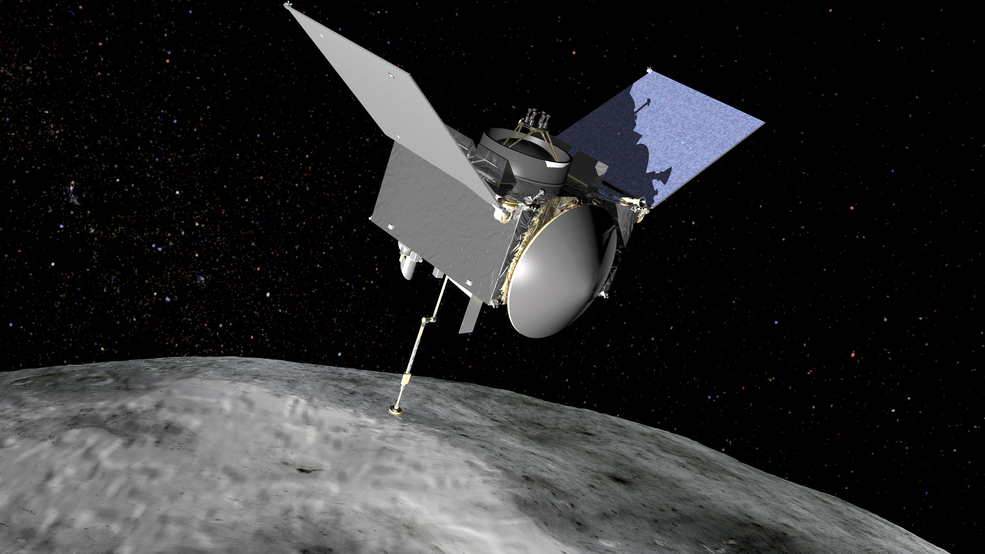
You might be mistaken for thinking Osiris-Rex and Bennu are the names of two rather exotic dogs. No.
Bennu is a 1,500 foot wide space rock, which circles the Sun at around 60,000 mph. OSIRIS-REx is the space probe which aims to catch the near-Earth asteroid in 2018 and return samples back to Earth in 2023. NASA is scheduled to launch OSIRIS-REx from aboard an Atlas V rocket on September 8, 2016, from Cape Canaveral in Florida. Follow NASA’s asteroid mission here.
In case you were wondering, as is NASA’s wont, OSIRIS-REx is of course a convoluted acronym for the Origins, Spectral Interpretation, Resource Identification, Security-Regolith Explorer spacecraft.
From the Guardian:
At Cape Canaveral air force station on the Florida coast stands an Atlas V rocket bearing the Osiris-Rex probe, Nasa’s first hope to smash-and-grab material from a speeding asteroid and bring it safely back to Earth.
The size of a transit van, the two-tonne spacecraft is set to blast off Thursday night on a seven-year mission to a 500m-wide ball of rubble called Bennu, which circles the sun at more than 100,000km per hour.
The probe is the third of Nasa’s ambitious New Frontiers missions. It follows on the heels of the New Horizons spacecraft, which last year beamed home stunning images from Pluto, and the Juno spacecraft, which arrived at Jupiter in July.
In returning a pile of asteroid to Earth, scientists hope to learn more about the source of water in the solar system and the origins of organic molecules from which life first arose. But getting their hands on pristine asteroid will also give researchers fresh clues about how to mine the bodies for valuable materials, and defend against wayward space rocks that may one day threaten our planet.
…
The mission has a title that is unwieldy even for the US space agency. Osiris-Rex stands for Origins, Spectral Interpretation, Resource Identification and Security-Regolith Explorer. “It is a mouthful,” said Ed Beshore, deputy principal investigator on the mission at Arizona State University. “But the name really does speak to our principal mission objectives.”
Bennu orbits the sun on a similar path to Earth. Classified as a “potentially hazardous asteroid”, it swings close to the Earth – in cosmic terms, at least – once every six years. The nearest encounter scientists can predict is slated for 2135, when the coal-black space rock will hurtle between Earth and the moon at a distance of 300,000km.
One major question the mission will ask is how sunlight affects the orbits of asteroids. As they spin close to the sun asteroids are constantly heating up and cooling down. The heat the asteroid re-emits to space provides a minuscule thrust which over time can alter its course. But the effect is hard to quantify. “Often when we look at asteroids that may be a hazard to Earth, the limiting factor in predicting the orbit is this process called the Yarkovsky effect,” said Beshore. “We’d like to understand that and measure it much more precisely when we’re at Bennu and in doing so improve our predictive accuracy for other asteroids that may represent a future threat to Earth.”
Osiris-Rex aims to catch up with Bennu in August 2018 and spend two years mapping the surface. When mission scientists find a good spot, it will swoop down, blast the asteroid with a powerful jet of nitrogen, and collect dislodged material with a robotic arm. Once the material is safely aboard, the spacecraft will retreat and later send it home in a capsule due to land via parachute in the Utah desert in 2023.
Read the whole story here.
Image: Artist concept of OSIRIS-REx probe traveling to near-Earth asteroid Bennu on a sample return mission. Courtesy: NASA.
